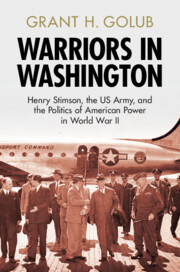Refine search
Actions for selected content:
22 results
Chapter 4 - The Athenian Empire and the Peloponnesian War
-
-
- Book:
- Reassessing the Peloponnesian War
- Published online:
- 21 August 2025
- Print publication:
- 04 September 2025, pp 63-92
-
- Chapter
- Export citation
5 - The Proper and Orthodox Way of War
-
- Book:
- Warriors in Washington
- Published online:
- 23 June 2025
- Print publication:
- 10 July 2025, pp 125-158
-
- Chapter
- Export citation
2 - Into the Dark
-
- Book:
- Warriors in Washington
- Published online:
- 23 June 2025
- Print publication:
- 10 July 2025, pp 34-60
-
- Chapter
- Export citation

Warriors in Washington
- Henry Stimson, the US Army, and the Politics of American Power in World War II
-
- Published online:
- 23 June 2025
- Print publication:
- 10 July 2025
The Italian Resistance: historical junctures and new perspectives
-
- Journal:
- Modern Italy / Volume 30 / Issue 2 / May 2025
- Published online by Cambridge University Press:
- 08 May 2025, pp. 125-130
- Print publication:
- May 2025
-
- Article
-
- You have access
- Open access
- HTML
- Export citation
8 - Double Visions (1)
-
- Book:
- Berlin
- Published online:
- 13 February 2025
- Print publication:
- 30 January 2025, pp 161-184
-
- Chapter
- Export citation
2 - Europe’s Zero Hour: Population Transfers in the Aftermath of WWII
- from Part I - Introduction
-
- Book:
- Uprooted
- Published online:
- 07 November 2024
- Print publication:
- 21 November 2024, pp 31-62
-
- Chapter
- Export citation
4 - Compliance by the United States
-
- Book:
- Perceptions of State
- Published online:
- 07 June 2024
- Print publication:
- 27 June 2024, pp 104-154
-
- Chapter
- Export citation
15 - Diplomatic Negotiation
-
-
- Book:
- Diplomatic Tradecraft
- Published online:
- 15 March 2024
- Print publication:
- 28 March 2024, pp 320-349
-
- Chapter
- Export citation
5 - Colonial Transplantation
-
- Book:
- Neutrality and Collaboration in South China
- Published online:
- 01 June 2023
- Print publication:
- 15 June 2023, pp 196-235
-
- Chapter
- Export citation
7 - Talking, Shouting Back, and Listening Better
-
- Book:
- Hanging Together
- Published online:
- 07 July 2022
- Print publication:
- 21 July 2022, pp 115-140
-
- Chapter
- Export citation
5 - A Military Geography
-
-
- Book:
- The Architecture of Confinement
- Published online:
- 17 February 2022
- Print publication:
- 24 February 2022, pp 144-178
-
- Chapter
- Export citation
9 - Alternative Trajectories: Seeing like Parastates, Militias, and Strongmen
- from Part II - Disassemblage/Reassemblage, 1947–1953
-
- Book:
- The First Vietnam War
- Published online:
- 17 August 2021
- Print publication:
- 26 August 2021, pp 235-258
-
- Chapter
- Export citation
4 - The Great Panathenaia: Ritual and Reciprocity
-
- Book:
- Serving Athena
- Published online:
- 17 April 2021
- Print publication:
- 11 March 2021, pp 116-170
-
- Chapter
- Export citation
7 - Creating Identities at the Great Panathenaia: Other Residents and Non-Residents
-
- Book:
- Serving Athena
- Published online:
- 17 April 2021
- Print publication:
- 11 March 2021, pp 253-313
-
- Chapter
- Export citation
5 - The Contested Treaty
- from Part I - Making the Anglo-Italian Entente (1911–1915)
-
- Book:
- Britain and Italy in the Era of the Great War
- Published online:
- 08 December 2020
- Print publication:
- 10 December 2020, pp 67-72
-
- Chapter
- Export citation
5 - The Politics and Practices of Allied Relief
-
- Book:
- The Hunger Winter
- Published online:
- 04 July 2020
- Print publication:
- 23 July 2020, pp 127-163
-
- Chapter
- Export citation
8 - After North Africa
-
- Book:
- Strangling the Axis
- Published online:
- 04 June 2020
- Print publication:
- 25 June 2020, pp 173-197
-
- Chapter
- Export citation
7 - The End in North Africa and the Shipping Crisis
-
- Book:
- Strangling the Axis
- Published online:
- 04 June 2020
- Print publication:
- 25 June 2020, pp 148-172
-
- Chapter
-
- You have access
- HTML
- Export citation
8 - Buying Allies
-
- Book:
- Rules and Allies
- Published online:
- 15 July 2019
- Print publication:
- 25 July 2019, pp 203-222
-
- Chapter
- Export citation
